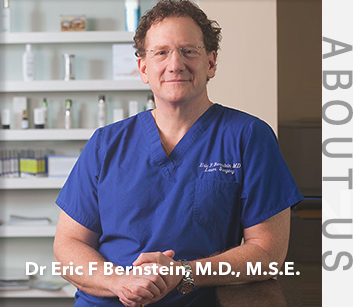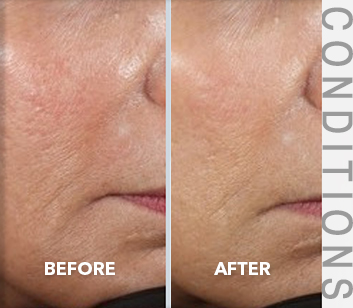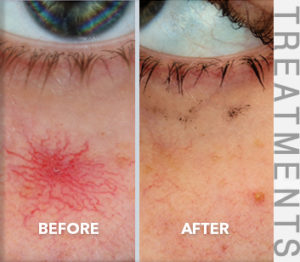Conditions
Acne Scarring
Results of Treatment
Laser Acne Scar treatment usually lasts a very long time in most people. It’s hard to determine if the changes are permanent as we continue to age our skin all the time.
About Acne Scarring
Acne is an inflammatory condition involving hair follicles. Hair follicles become plugged with keratin and oil produced by the oil, or sebaceous glands, which is acted upon by the acne-causing bacteria, creating compounds that are irritating to the skin. Those compounds cause irritation in the hair follicle, resulting in a massive inflammatory reaction. This causes a typical, red acne bump. People with dark skin or those with the ability to tan frequently get brown spots at the site of acne marks. This happens because the surface layer that contains melanin pigment to protect us from the sun is temporarily damaged. This pigment, which is supposed to reside in the top layer of skin (the epidermis), then falls into the deeper layer of skin (the dermis). This is especially true if the person with the pigment is constantly in the sun. Although they can last a very long time, these brown marks are not usually permanent scars and thus can be made to go away with topical treatments.
If the inflammation is too great, the skin surrounding the hair follicle is damaged and a scar can result. Scars are composed mostly of collagen that is arranged differently than the collagen of non-scarred skin. Acne scars are usually depressed areas of skin at the site of severe acne. They can be shallow depressions or become deep holes, as with “ice-pick”-type scars. Acne scars on the body are often red and raised, these scars are best treated with corticosteroid injections to flatten the scar, which may take a series of monthly injections. Once flat, vascular laser treatment will improve the texture and remove the redness.
I often use a combination of laser treatments to improve acne scars. Red acne scars can be treated first with a vascular laser, such as the V-Beam Prima® or Excel-V® lasers followed by a fractionated laser, such as the Fraxel Dual, CO2RE®, UltraPulse® with ActiveFX® and Deep FX®, PicoWay® Resolve or PicoSure® lasers, or a fractionated radiofrequency needling device such as the INTRAcel®. Vascular lasers target the redness within the scar, so if there’s not redness, there won’t be much of a response. Not only does the laser remove the redness, but it induces an inflammatory response as evidenced by some redness and swelling after treatment, and that inflammation helps remodel the scars. Fractionated lasers make tiny little injuries in the skin, leaving the intervening skin untouched resulting in little downtime and faster healing than if the whole skin surface was treated.
Dr. Bernstein was the first physician in the world to use the PicoWay® Resolve and published a peer-reviewed manuscript on its use to improve acne scarring.
Most treatments result in no, or very little, down time. Most often, a series of 2-4 treatments is best for improving acne scars. Acne itself may also improve following laser treatment, and the improvement can be long-lasting in many cases, although response of acne is often more variable than the consistent improvement most often seen following treatment of acne scarring.
To answer your specific questions or schedule a consultation, call Dr Bernstein today of 610-645-5551.
Did you know?
Dr. Bernstein was the first physician in the world to use the PicoWay® Resolve 1,064 nm and 532 nm lasers and has published numerous peer-reviewed articles on treating conditions with the PicoWay®, including acne scarring.
Acne Scarring FAQs
HOW DOES ACNE SCARRING TREATMENT WORK?
Beams of laser light treat redness in scars or make tiny microinjuries in the skin to stimulate a healing response. This response breaks up the abnormal collagen forming the scar replacing it with more normal collagen bundles.
WHO IS A CANDIDATE FOR ACNE SCARRING? WHO IS NOT AND WHY?
Although initially laser acne scar treatment worked best for people with lighter skin because lasers could hurt the skin and create abnormal pigmentation in darker skin types, the PicoWay® laser and INTRAcel® RF microneedling device can treat all skin types from I-VI. So everyone with acne scarring may be treated.
WHAT ARE THE ADVANTAGES OF LASER AND RF TREATMENT COMPARED TO OTHER METHODS?
Sometimes people receive filler in the face in an attempt to improve acne scarring. Fillers often track around scars making them more prominent, and they also only last for months at a time. Laser treatments are more long-lasting than fillers in most situations for treating acne scarring.
HOW MANY LASER TREATMENTS DOES IT TAKE TO IMPROVE ACNE SCARS?
Typically, we administer 2-4 treatments with 2 being a minimum number of treatments. One treatment often results in temporary improvement so don’t start unless you can plan for 2 treatments. After a maximum of 4 treatments, it’s important to wait 6-12 months to see the extent of improvement one is going to get. This can save time and money.
IS LASER ACNE SCAR TREATMENT PERMANENT?
Improvement usually lasts a very long time in most people. It’s hard to determine if the changes are permanent, as we continue to age our skin all the time. Signs of aging, such as sagging skin can be superimposed upon acne scarring, making some people return after a number of years for a treatment or 2.
DOES LASER ACNE SCAR TREATMENT HURT?
Most people find the treatments tolerable but mildly uncomfortable. We use numbing cream before the treatment for some lasers, but don’t need it for most of the treatments.
WHAT ARE THE COMMON SIDE EFFECTS?
Side-effects of laser acne scar treatment are similar to those from any laser treatment. There is redness (usually pink) of the skin immediately following treatment and swelling following treatment. Changes in pigmentation are rare but possible after some lasers in more darkly pigmented people, although RF microneedling and picosecond lasers have very little risk of pigmentation in even very darkly pigmented skin.
WHAT AREAS OF THE BODY CAN BE TREATED?
Acne scars can be treated with lasers all over the body. The face is one of the most common areas to be treated, along with the back, shoulders and chest.
HOW WILL I LOOK AND CARE FOR THE TREATED AREA?
Most people just look a pink and puffy following laser treatment of acne scars. This normally lasts for a few days, but can sometimes last longer.
WHAT ABOUT CONTINUED ACNE TREATMENT?
Following treatment, most people discontinue their topical acne medications for a few days. Oral acne medications (other than Accutane®) do not need to be discontinued. It is crucial to consistently treat acne so new scars do not form.







